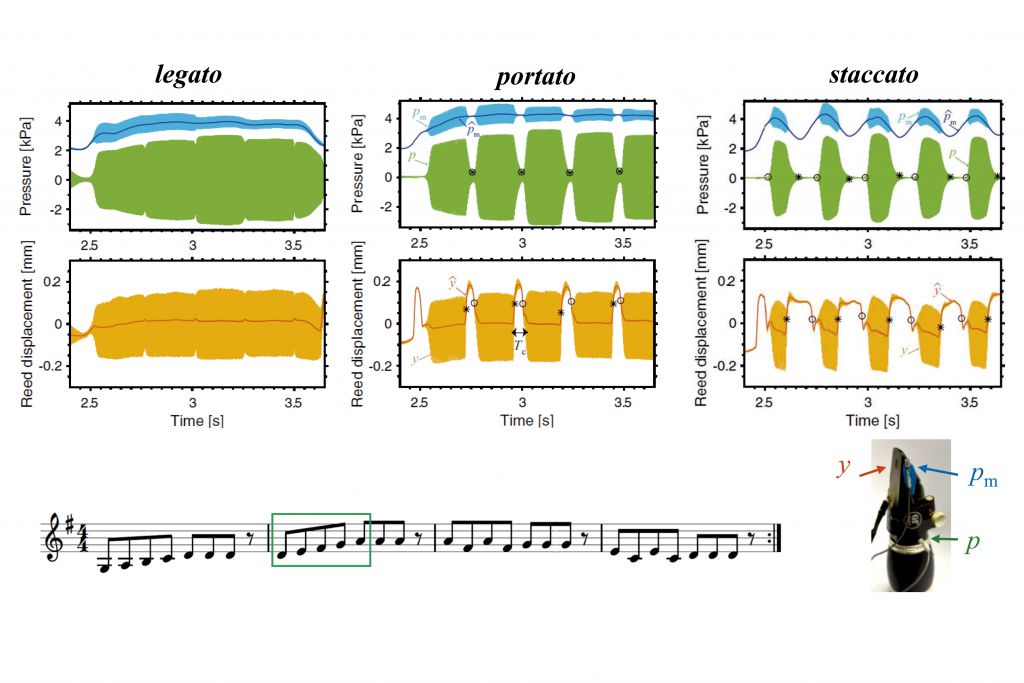In music acoustics, the process by which player actions affect the acoustics of an instrument is known as “player-instrument interaction”, which is a research topic that has been investigated in connection with a broad variety of instruments. In single-reed woodwind instruments such as the clarinet and saxophone, sound is produced by the vibration of a single reed attached to a mouthpiece. The tip of the reed-mouthpiece system is placed inside the player’s mouth, and it interacts with the blowing and tongue actions as well as with the player’s oral cavity. These three elements were the focus of this PhD dissertation, which aimed to determine the effect of player actions on the attack and release transients of notes. In other words, systematic experimental methods were employed in order to examine how tongue, blowing and vocal tract actions affect notes’ beginnings and endings. A key factor in this analysis is articulation—i.e., the ways in which players connect (as in legato) or detach (as in staccato) a series of notes. Articulation is known to be controlled by tongue-reed interaction: when the tongue makes contact with the reed, the reed is dampened and therefore the note ends, whereas when the tongue is released from the reed’s surface in combination with sufficient blowing pressure, a note can begin. This indicates that tonguing and blowing actions interact to generate sounds. To analyse the effect of articulation on the sound that is produced, two experimental procedures were carried out: measurements under real playing conditions with instrumentalists and measurements under artificial blowing conditions in the laboratory.
A study involving eleven clarinet players (students and alumni of the mdw) investigated the influence of measurable physical variables on three musical characteristics (articulation, tempo, dynamics) and the resulting effects on sound. The experimental setup included ascertainment of blowing pressure, the pressure inside the mouthpiece, and reed oscillation (see figure below). Statistical analysis of the recorded note transitions produced some significant findings, pertaining in particular to the influence of tempo and dynamics on the blowing action as well as the different effects of using tonguing vs. blowing techniques to stop the notes.

This research also made use of an artificial blowing machine to recreate the playing situation while assuring controlled blowing pressure and permitting a direct view of the reed during sound production. Artificial playing conditions were required to calibrate the strain gauge sensors used to measure the oscillations of the reed. In order to accomplish this, it was necessary to undertake synchronous measurement of the strain gauge sensor signal and optical measurement of the reed displacement via a high-speed camera. This setup was also equipped with an automated tongue, which was computer-controlled and set to reproduce different articulation styles. Such a blowing machine can be used to analyse instrument properties for purposes such as investigating how changes in mouthpiece design can influence certain sound characteristics, as was demonstrated in a study we did in collaboration with Politecnico di Milano. Another analysis of tonguing and blowing actions was carried out at the Department of Music Acoustics – Wiener Klangstil (IWK) using a physical model developed in-house. This computer simulation of a single-reed woodwind instrument took advantage of measurements obtained using both a blowing machine and real players for the purpose of synthesising the playing of musical phrases on the clarinet or saxophone.
Vocal tract modifications are known to be used by single-reed woodwind players to perform some extended sound effects and to play at the highest pitches. Up to now, there has been no consensus as to the effects that these modifications might have during note transitions. Therefore, an experiment with five saxophone players that sought to analyse the effects of the vocal tract on sound production was carried out during a research stay at McGill University. Tasks including slow-varying pitch and fast-varying pitch were played and recorded using the experimental setup described above. The results showed the time intervals at which mouth resonance affected reed oscillation, which was also observed at some note transitions. In a similar manner, a clarinet concerto was analysed in order to investigate the effect of the vocal tract on the sound of the clarinet. The analysis, which considered the performances of eleven clarinet players, included notes situated throughout the clarinet register and articulated in diverse ways. Evidence of vocal tract effects was found in all registers beginning in the upper chalumeau register (throat register), effects that grew more intense with ascending pitch. And in the highest register, only the notes performed with apparent vocal tract influence exhibited clear attacks.
The results of this dissertation may help not only acousticians but also musicians and pedagogues obtain a better understanding of the interactions between instruments and players in the context of sound production. Read it here.
Open-access publications related to this work:
Montserrat Pàmies-Vilà, Alex Hofmann, Vasileios Chatziioannou (2018), Analysis of tonguing and blowing actions during clarinet performance, Frontiers in Psychology, 9, 617, https://doi.org/10.3389/fpsyg.2018.00617
Vasileios Chatziioannou, Sebastian Schmutzhard, Montserrat Pàmies-Vilà, Alex Hofmann (2019), Investigating Clarinet Articulation Using a Physical Model and an Artificial Blowing Machine, Acta Acustica united with Acustica 105 (4), 682–694., https://doi.org/10.3813/AAA.919348
Montserrat Pàmies-Vilà, Alex Hofmann, Vasileios Chatziioannou (2020), The influence of the vocal tract on the attack transients in clarinet playing, Journal of New Music Research, 49 (2), 126–135., https://www.tandfonline.com/doi/full/10.1080/09298215.2019.1708412

